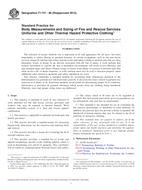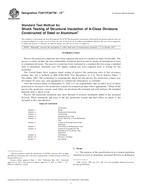Potřebujeme váš souhlas k využití jednotlivých dat, aby se vám mimo jiné mohly ukazovat informace týkající se vašich zájmů. Souhlas udělíte kliknutím na tlačítko „OK“.
ASTM E2912-13
Standard Test Method for Fire Test of Non-Mechanical Fire Dampers Used in Vented Construction
Automaticky přeložený název:
Standardní zkušební metoda pro požární Test Non-mechanických požárních klapek Používá se ve stavebnictví tahokov
NORMA vydána dne 1.7.2013
Informace o normě:
Označení normy: ASTM E2912-13
Poznámka: NEPLATNÁ
Datum vydání normy: 1.7.2013
Kód zboží: NS-46255
Počet stran: 20
Přibližná hmotnost: 60 g (0.13 liber)
Země: Americká technická norma
Kategorie: Technické normy ASTM
Kategorie - podobné normy:
Anotace textu normy ASTM E2912-13 :
Keywords:
closed state, damper, fire, fire-test-response characteristic, gap, insulation, integrity, non-mechanical fire damper, open state, open state fire performance, opening, splice, vent, vented construction, void, ICS Number Code 13.220.99 (Other standards related to fire protection)
Doplňující informace
| Significance and Use | ||||||||||||||||||||||||
|
5.1 This test method provides for the following observations, measurements and evaluations of an open state during the test fire. 5.1.1 Ability of the test specimen to resist the passage of flames, radiation, and hot gases caused by sudden direct flame impingement. 5.1.2 Transmission of heat through the test specimen. 5.2 This test method does not provide the following: 5.2.1 Evaluation of the degree to which the test assembly contributes to the fire hazard by generation of smoke, toxic gases, or other products of combustion. 5.2.2 Measurement of the degree of control or limitation of the passage of smoke or products of combustion through the test specimen or the test assembly. 5.2.3 Measurement of flame spread over the surface of the test specimen or the test assembly. 5.2.4 Durability of the test specimen or test assembly under actual service conditions, including the effects of cycled temperature. 5.2.5 Effects of a load on the test specimen or test assembly. 5.2.6 Any other attributes of the test specimen or the test assembly, such as wear resistance, chemical resistance, air infiltration, water-tightness, and so forth. 5.3 The results of this test method shall not be used as an alternative to, or a substitute for, requirements for a required fire resistance rating of building construction. |
||||||||||||||||||||||||
| 1. Scope | ||||||||||||||||||||||||
|
1.1 This fire-test-response standard assesses the ability of non-mechanical fire dampers used in vented construction in its open state to limit passage of hot gases, radiation, and flames during a prescribed fire test exposure. The fire exposure condition in this test method is sudden direct flame impingement, which produces these hot gases, radiation, and flames. 1.2 This fire-test-response standard
is intended to provide a means to assess the reaction of a
non-mechanical fire damper used in vented construction to sudden
direct flame impingement, or as a supplement to existing
fire-resistive test methods, or both.
1.3 This test method does not circumvent or eliminate the fire resistance rating requirements for construction. The fire resistance rating of construction shall be tested in accordance with published fire-resistance test standards as appropriate for the relevant application of the construction, or as required by the authority having jurisdiction (regulatory authority), or both. Non-mechanical fire dampers shall be tested to the appropriate fire-resistive test standards required for their application in order to determine a fire resistance rating in those constructions. 1.4 This test method specifies the
fire exposure conditions, fire test protocol, and criteria to
evaluate an open state.
1.5 Results generated by this test
method provide the following information:
1.5.1 the open state fire performance of vented construction, and 1.5.2 the non-mechanical fire damper’s fire-test-response characteristic when exposed to sudden direct flame impingement. 1.6 This test method does not provide quantitative information about the test assembly related to the leakage of smoke, or gases, or both. 1.7 This test method does not apply to a test assembly having other components than those tested. 1.8 This standard is used to measure and describe the response of materials, products, or assemblies to heat and flame under controlled conditions, but does not by itself incorporate all factors required for fire hazard or fire risk assessment of the materials, products, or assemblies under actual fire conditions. 1.9 The text of this standard references notes and footnotes which provide explanatory material. These notes and footnotes (excluding those in tables and figures) shall not be considered requirements of this standard. 1.10 The values stated in SI units are to be regarded as standard. No other units of measurement are included in this standard. 1.11 Fire testing is inherently hazardous. Adequate safeguards for personnel and property shall be employed in conducting these tests. 1.12 This standard does not purport to address all of the safety concerns, if any, associated with its use. It is the responsibility of the user of this standard to establish appropriate safety and health practices and determine the applicability of regulatory limitations prior to use. |
||||||||||||||||||||||||
| 2. Referenced Documents | ||||||||||||||||||||||||
|
Podobné normy:
Historická
1.7.2014
Historická
1.4.2012
Historická
1.5.2014
Historická
1.7.2013
Historická
1.5.2013
Historická
1.9.2008
Doporučujeme:
Aktualizace technických norem
Chcete mít jistotu, že používáte pouze platné technické normy?
Nabízíme Vám řešení, které Vám zajistí měsíční přehled o aktuálnosti norem, které používáte.
Chcete vědět více informací? Podívejte se na tuto stránku.



 ASTM E1618-14
ASTM E1618-14 ASTM E2226-12
ASTM E2226-12 ASTM E2886/E2886M-14..
ASTM E2886/E2886M-14.. ASTM F1731-96(2013)..
ASTM F1731-96(2013).. ASTM F2877/F2877M-13..
ASTM F2877/F2877M-13.. ASTM G145-08
ASTM G145-08
 Cookies
Cookies
